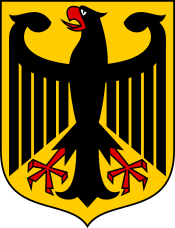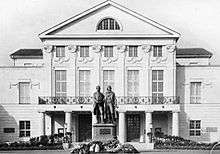Weimar National Assembly
| Weimar National Assembly Weimarer Nationalversammlung | |
|---|---|
| Constituent Assembly of the Weimar Republic | |
 | |
| Type | |
| Type | |
| History | |
| Established | 1919 |
| Disbanded | 1920 |
| Preceded by | Imperial Reichstag |
| Succeeded by | Weimar Reichstag |
| Seats | 421 |
| Elections | |
| Direct competitive elections | |
Last election | 19 January 1919 |
| Meeting place | |
 | |
| Deutsches Nationaltheater, Weimar | |
The Weimar National Assembly (German: Weimarer Nationalversammlung) was the constitutional convention and de facto parliament of Germany from 6 February 1919 to 6 June 1920. It drew up the new constitution which was in force from 1919 to 1933, technically remaining in effect even until the end of Nazi rule in 1945. It convened in Weimar, Thuringia and is the reason for this period in German history becoming known as the Weimar Republic.

Background
With the end of the First World War and the start of the November Revolution, Chancellor Max of Baden announced the abdication of the German Emperor Wilhelm II on 9 November 1918. He also appointed Friedrich Ebert as his own successor as Chancellor. The Council of the People's Deputies, a provisional government consisting of three delegates from the Social Democratic Party (SPD) and three from the Independent Social Democratic Party (USPD), took over the executive power on the following day and called for a National Congress of Councils on 16 to 21 December to convene in Berlin. This Reichsrätekongress set elections for a national assembly to take place on 19 January 1919.[1]
Elections
The elections for the National Assembly on 19 January 1919 were the first elections in Germany after the introduction of women's suffrage.[2] The legal voting age had been lowered from 25 to 20 years. Together, these changes raised the number of eligible voters by around 20 million.[3] The turnout rate was 83%,[2] a slightly lower percentage than in the last Reichstag elections in 1912, but a much greater absolute turnout due to the expanded suffrage.[3] Among women the turnout was 90%.[4]:17
The election yielded a 38% plurality for the SPD, with the Center Party (Zentrum) getting 20% of the votes, the German Democratic Party (DDP) over 18%, the right-wing German National People's Party (DNVP) just over 10%, and the Independent Social Democrats (USPD) over 7%. The German People's Party (DVP), Bavarian Peasants' League (BB), German-Hanoverian Party (DHP), Schleswig-Holsteinische Bauern- und Landarbeiterdemokratie (SHBLD), and Brunswick Election-Union (BLWV) each attained less than five percent of the vote. The Communist Party, founded in December 1918, boycotted the elections. Although SPD and USPD had been instrumental in introducing women's suffrage, most women voted for the DDP and DNVP (in Protestant parts of the country) or the Zentrum or BVP (in Catholic parts).[4]:17 The parties were attributed a number of seats proportional to the number of votes they received.[3][5] Out of a total of 416 delegates just 37 were women.[4]:17 The so-called "Weimar Coalition" of SPD, Centre Party and DDP held an absolute majority of the seats.[3]
Establishment

The National Assembly met in Weimar for several reasons: the politicians wanted to avoid the ongoing fights in the capital Berlin, and SPD leader Friedrich Ebert wanted to remind the victorious World War I Allies, who were at the time deliberating a peace treaty, of Weimar Classicism, which included the likes of Goethe and Schiller.[4]:17
Important events and decisions
- 6 February 1919 - Friedrich Ebert, as Chairman of the Council of the People's Deputies, opened the first session of the Nationalversammlung
- 10 February 1919 - Against the votes of the USPD the assembly passed the Gesetz über die vorläufige Reichsgewalt (law on temporary power in the Reich). It denoted the assembly itself as legislative and set up the position of Reichspräsident, who was to be in charge of "the Reich's government affairs". An assembly of the individual states (Staatenausschuss) was to be created
- 11 February 1919 - Friedrich Ebert was elected provisional Reichspräsident. He asked Philipp Scheidemann to form a government and serve as Reichsministerpräsident
- 13 February 1919 - the Weimar Coalition formed a government (Kabinett Scheidemann) based on the Weimar Coalition
- 14 February 1919 - Konstantin Fehrenbach (Centre Party) was elected President of the National Assembly
- 18 February 1919 - the Staatenausschuß decided that black-red-gold would be the national colours
- 27 February 1919 - the assembly passed the Gesetz über die Bildung einer Vorläufigen Reichswehr setting up a provisional military in accordance with the terms of the Armistice. By 1921, the armed forces were to be transformed into a professional army without conscripts. The number of land troops was to be cut from 800,000 to 100,000
- 4 March 1919 - the assembly passed the Übergangsgesetz that clarified the legal position of Imperial laws and those passed by the Council of the People's Deputies
- 12 May 1919 - the National Assembly met for a protest rally against the Treaty of Versailles, Scheidemann called it "inacceptable"
- 20/21 June 1919 - the Scheidemann government resigned, next day Gustav Bauer (SPD) formed a new government
- 22 June 1919 - with the approval of the assembly the new government declared itself ready to accept the Treaty if the admission of Germany's sole responsibility for the war is dropped
- 3 July 1919 - the assembly accepted the new national colours
- 7 July 1919 - Finance minister Matthias Erzberger (Centre Party) presented his fiscal reforms including the introduction of the first German income tax and fiscal burden sharing
- 9 July 1919 - the assembly ratified the Treaty of Versailles and the regulatory statutes about the military occupation of the Rhineland
- 31 July 1919 - the assembly passed the Weimar Constitution based on a draft by DDP delegate Hugo Preuß with 262 delegates voting for and 75 (USPD, DNVP and DVP) against
- 11 August 1919 - Reichspräsident Ebert signed the constitution. It came into force on 14 August 1919. Final meeting of the assembly in Weimar.
- 30 September 1919 - first meeting of the assembly at Berlin after law and order were deemed to have been restored in the capital
- 17 December 1919 - the assembly passed the Reichsnotopfergesetz that called for a one-off wealth tax to pay for the national debt
- 18 January 1920 - the assembly passed the law on workers' councils (Betriebsrätegesetz)
- 13 March 1920 - the assembly left Berlin as a result of the Kapp Putsch, it returned from Stuttgart seven days later
- 25/26 March 1920 - the government of Chancellor Gustav Bauer resigned, the next day president Ebert asked Hermann Müller (SPD) to form a new government
- 8 May 1920 - the Gesetz zur Befriedung der Gebäude des Reichstags und der Landtage came into force, establishing a security zone around parliamentary buildings in which demonstrations are not allowed
- 12 May 1920 - the Reichslichtspielgesetz came into force, it was the basis for movie censorship
- 20 May 1920 - supported by the SPD the majority of the assembly called on the government to end the state of emergency in all of Germany. The government refused.[2][6][7][8]
Dissolution
On 21 May 1920 the National Assembly dissolved itself.[6] After the first elections based on the new constitution took place on 6 June 1920, the Reichstag took over the role of the National Assembly.[9]
Presidents of the Weimar National Assembly
| Name | Party | Entered Office | Left Office |
|---|---|---|---|
| Eduard David | SPD | 7 February 1919 | 13 February 1919 |
| Conrad Haussmann (acting) | 13 February 1919 | 14 February 1919 | |
| Konstantin Fehrenbach | Centre Party | 14 February 1919 | 21 June 1920 |
See also
| Wikimedia Commons has media related to Weimar National Assembly. |
- Herrenchiemsee convention of 1948
- Parlamentarischer Rat of 1949
References
- ↑ Reichskongreß der Arbeiter- und Soldatenräte in dhm.de/lemo. Retrieved 10 December 2007. (German)
- 1 2 3 "Chronologie 1919 (German)". Deutsches Historisches Museum. Retrieved 23 July 2013.
- 1 2 3 4 Die Wahlen zur Nationalversammlung in dhm.de/lemo. Retrieved December 10, 2007. (German)
- 1 2 3 4 Sturm, Reinhard (2011). "Weimarer Republik, Informationen zur politischen Bildung, Nr. 261 (German)". Bonn: Bundeszentrale für politische Bildung. ISSN 0046-9408. Retrieved 17 June 2013.
- ↑ Election results in dhm.de/lemo. Retrieved December 10, 2007. (German)
- 1 2 "Chronologie 1920 (German)". Deutsches Historisches Museum. Retrieved 23 July 2013.
- ↑ "Friedrich Ebert (1871-1925). Vom Arbeiterführer zum Reichspräsidenten (German)". Friedrich Ebert Stiftung. Retrieved 23 July 2013.
- ↑ "Files of the Reichskanzlei: Kabinett Scheidemann, Einleitung II (German)". Bundesarchiv. Retrieved 23 July 2013.
- ↑ Die Nationalversammlung in dhm.de/lemo. Retrieved 10 December 2007. (German)